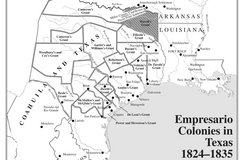The prospect of colonizing Texas following Mexican independence from Spain in 1821 presented enormous challenges for those inhabiting Texas and the nascent government in Mexico City. As discussed in the overview essay by Dr. Andrew Torget, one of Spain’s greatest strategic blunders in the Americas was their inability to populate Texas and provide meaningful security and stability to those living there.
Following independence, the Mexican government was beleaguered by instability and debt, and Mexican citizens in Texas lived in fear of frequent Indian raids. Both prioritized colonizing Texas in the early 1820s, but questions remained as to the best way to do so.
Anglo empresarios from the United States, notably Stephen F. Austin, and prominent Tejanos saw economic opportunity in Mexico’s quandary. After achieving independence, the Mexican government ratified a colonization law in 1825 that opened Texas to foreign colonists. Following the cotton boom of the 1810s and the Panic of 1819, desirable land in Mississippi and Alabama could be as much as $50 per acre, while land in Texas would be available for 12.5 cents per acre.
For the Mexican government, a new Anglo colony in Texas would bring its own unique complications —issues of loyalty, slavery, and adherence to the state religion—Catholicism. The incentives were enormous: national security, population stability, and economic livelihood. Powerful stakeholders agreed that colonizing Texas was a priority, but they had disagreements over why and how to do so.
In this lesson, students will examine the conditions in Texas in the immediate aftermath of Mexican independence by studying different perspectives. Students will analyze the unique and shared experiences of the Mexican citizens in Texas, the Mexican government, and Anglo colonists. Students will consider the effect of perspectives on historical narratives.

